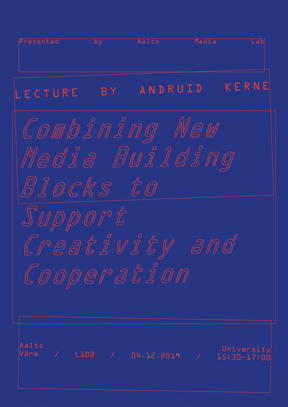Lecture: Andruid Kerne - Combining New Media Building Blocks to Support Creativity and Cooperation

When
Where
Event language(s)
Anduid Kerne
Professor, Computer Science & Engineering
Director, Interface Ecology Lab
Program Director, Information and Intelligent Systems Division, National Science Foundation (NSF)
Combining New Media Building Blocks to Support Creativity and Cooperation
We present findings from a sustained program of transdisciplinary research into how new media can support creativity and cooperation. The investigation addresses new media in the world—e.g., Twitter, Twitch, and Pinterest—as well as research prototypes spanning algorithm-in-the-loop information composition, multiscale design curation, and zero-fidelity simulation game play. Over the course of the research, we developed methods for studying creativity and cooperation, despite confounds. We employed these mixed methods over a gamut of studies, spanning qualitative grounded theory and quantitative ideation analytics. We found support for creativity and cooperation results from combining new media building blocks, including visual representation, spatial organization, semantic metadata, bimanual interaction, time-based visualization, information distribution, up and down votes, cool text, and hot video.
Biography
Andruid Kerne is an interdisciplinary researcher working to invent the future of human expression. My Interface Ecology Lab develops human-centered systems that amalgamate design, algorithms, semantics, software, and hardware. In conjunction with computing, we synthesize methods from art, design, psychology, and sociology.
Kerne holds a B.A. in applied mathematics / electronic media from Harvard, an M.A. in music composition from Wesleyan, and a Ph.D. in computer science from NYU. He has published over 100 papers and raised over $3M in research funding. Kerne is also the Program Chair of ACM Creativity and Cognition 2019.
Kerne creates provocative dynamics of thought, emotion, and participation in and around information environments, tools, installations, and performances. His work opens the range of expressive, creative, and social processes embodied by computational artifacts, developing interactivity in terms beyond efficiency: ideation, play, participation, and delight.
- Published:
- Updated: